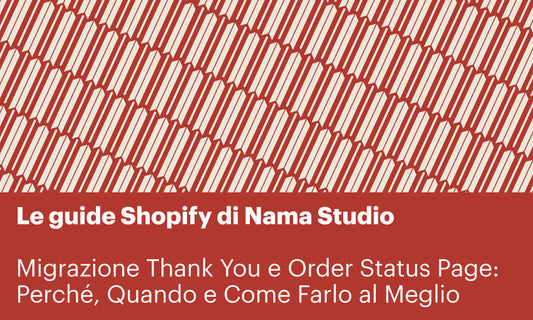Today we'll cover the following topics:
- What is on-page SEO and why is it important?
- How to optimize meta title tags on Shopify
- How to optimize meta description tags on Shopify
- How to optimize URLs
- How to modify on-page SEO on Shopify
If you wish to start a free trial on Shopify, you can do it here.
What is on-page SEO and why is it important?
On-page SEO, also called on-site SEO, is the practice of optimizing elements within a page to obtain a better ranking on search engines and receive a higher quality traffic. It is different from off-site SEO, that refers to external elements such as backlinks.
First of all on-page SEO helps Google to efficiently interpret your page content and display it to the right audience. For this reason search engines reward websites with a good SEO, positioning them in higher rankings between the search results.
Another aspect to keep into account is that optimizing these elements allows users to quickly and easily understand which content to expect if they click on the link, and guess if the content can fit their search. The result is a lower page abandon rate, which impacts on the trust of search engines in your page.
How to optimize meta title tags on Shopify
The meta title is a HTML element that is separate from the page title, and that clarifies what is in the page is about.
For the website visitors it is only visible as the browser tab title, but it is indeed one of the most important SEO elements for search ranking and social share. The meta title is detected by search engines and displayed as a clickable title for each search result:

Shopify automatically generates meta titles for each page, but it is important to optimize them with SEO in mind.
Some recommendations to optimize meta title tags:
- Every store page should have a different meta title. Google hates duplicate content and it actively penalize websites that feature a lot of duplicate content. It is therefore fundamental to differentiate each page of your Shopify store, products included.
- Use meta titles that are appropriate for the page you are editing. Being precise helps meeting your visitors' expectations, and reduces the abandon rate of your website. To make your products more descriptive you could for example include the material (i. e. silk shirt) or specify the use (i. e. tea cup) of the product.
- Write short titles. Shopify allows up to 70 characters, but Google tends to show only 50-60 characters, therefore it is better to stick to this limit.
- Make good use of organic keywords. Putting one or two keywords at the beginning of the title tag is considered a good practice. Don't exaggerate though: Google detects and penalizes keyword stuffing
How to optimize meta description tags on Shopify
Meta description is a HTML tag that briefly summarizes the page content. Google doesn't use this tag directly for the results ranking, but a good text helps convincing the users to click on the link, enhancing the CTR. The click-through rate (CTR) is a factor that impacts on ranking, and therefore we have an indirect influence on ranking through meta description, making it a very important element for SEO.
The meta description is displayed on Google below the link and the meta tag.

Here are some recommendations to optimize meta description tags:
- The description must complement the meta title, and not repeat the same content. Its goal is to add some value, summarizing the most important info of the page content. A good approach is trying to imagine which extra info the users would need to decide if the link does represent the answer to their query. For example for the homepage it is a good practice to give relevant info around your business and brand. For product meta descriptions it is important to ask yourself what can convince users to finalize their purchase, why they need such a product and why should they buy it from your website specifically.
- Write short meta descriptions. Shopify allows up to 320 characters, but Google will only show the first 155-160, which is therefore the recommended length.
- Include the target keyword in the meta description. It should always be included both in the title and description.
- Write a captivating copy. The meta description is visible in the search results and serves as a sort of advertisement for the link: it is therefore important to include a CTA and attract users to the page.
How to optimize URLs
A correct URL optimization allows both users and search engines to understand easily what the linked page is about.
A SEO-friendly URL:
- Is accurate in its wording, and therefore easy to read since it describes thoroughly the linked page.
- Includes the target keyword, that must be included also in the meta tags.
- Is short and clear, ideally below 50-60 characters. Longer URLs tend to be penalized by Google.
- It uses the dash "-" to separate words and not the underscore "_" or other symbols
- It doesn't use stop words, which are words without a relevant meaning like "and", "with" or articles. Shopify automatically generates urls from the page title, and it is therefore good practice to remove such words before publishing the content.
When Shopify generates URLs, it adds a prefix that describes the type of content.
For example /products, /pages, /blogs, etc. From an SEO perspective it is not ideal, but keeping your URLs clean after the prefix will avoid being penalized by search engines.
Modifying the URL of content that is already published doesn't always have a positive impact on SEO. This is because, even if you create a redirect 301, the links to the old URL will have a limited SEO impact. It is therefore ideal to work on URLs before publishing a new page, product, or article.
How to modify on-page SEO on Shopify
Editing SEO on Shopify is very simple.
From your admin panel you need to access the page or content that you want to edit. Scrolling down on that page you will find a section called "Search Engine Listing Preview" and click on "Edit Website SEO".

This section contains the fields to edit the meta title, meta description and URL that have been automatically generated by Shopify based on the title and description content. If you change the URL make sure that the option "Create URL redirect" is selected.

On Shopify the homepage meta tags are edited in a different section. From the side menu of the admin panel, click on "Online Store" → "Preferences"
The first section of this page features the fields to set up the meta title and meta description for the homepage.

If you have a multilingual website and use a translation app like Langify you will be able to edit meta titles and meta descriptions directly from the app dashboard. You cannot though translate page URLs. You can find more info around multilingual websites on our dedicated article.
We haven't covered images alt texts in this article because we will shortly publish a guide on images optimization on Shopify. If you'd like to dig deeper on these topics, try Shopify for free or share some insights with us here.
-
If you are considering using Shopify for your online store, you can subscribe here for a free trial or email us at info@namastudio.it




